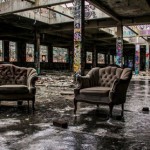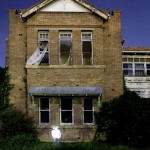I know you’ve done it. It’s okay to admit it. I’ve done it too! We all have! You’ve shot some terrible photographs.
Perhaps you shot the whole time in the wrong white balance, or you didn’t pay attention to shutter speed and everything is blurry. When this happens it’s incredibly disappointing. Frustrated and angry with yourself, you consider the experience a write-off, and delete the images. Then you head for the snack cupboard searching for some kind of solace.
But, everyone makes mistakes when they shoot, even professionals. There are times when we get excited and forget to check our settings, or make sure we are using the right lens for the right moment. It happens.

We were canoeing and in my rush to get an image of a small bird I underexposed the shot.
These failures don’t have to be a complete waste though. There’s nothing negative about making mistakes. Willie Nelson once said, “Once you replace negative thoughts with positive ones, you’ll start having positive results.”
So with that in mind, start looking at every photograph you take, as a step forward. Don’t delete those mistakes right away. You can learn a lot about taking good photographs from the missteps you make. I’ve met some photographers who have created a special file for all of their failures. Then when they have a little bit of time, they peruse through the collection and reflect upon them. This type of exercise can help you grow as a photographer.
There are lots of ways to reflect on your images. Some people make mental notes about their images. Others like to use a written journal format. I know of a few photographers who use the keyword section in Lightroom to make notes. I’ve even seen a detailed scrapbook in which the photographer printed out his failures and scribbled notes beside each. Just be sure to pick a format that works for you. Regularly reflecting on your work is important.
To start you down the path here’s a list of questions that you can use to help you reflect on your images.
Reflection Tips
- In the first few seconds of viewing the photograph, what was the first emotion you experienced? Why? Now let it go. Detach from the emotion and be critical.
- Why do you consider this image a failure? Don’t analyze too much just scribble down the first thought that comes to your mind. Try to make this part of the analysis a stream of consciousness.
- What were your goals or intentions when you shot this image? Why were you unable to meet those goals?
- If you could turn back time and reshoot the image what would you do differently?
- Think carefully about the image and come up with one key piece of learning that you can take away from this experience.
Now let’s practice your reflection skills. It’s not easy to analyze your own photographs; it can take some time to perfect. Let’s analyze some of my failures, and some successes.
View each image, and really look at it in a critical sense. You can use the guiding questions from above to help you. After you’ve finished your reflection, scroll down and take a look at my notes, see if you agree with my thoughts. Perhaps you noticed something different then I did.

What did you come up with? Keep in mind there’s no right or wrong to this whole process. Some people might argue the image isn’t a failure. I personally, hate it.
Notes about the image
- I cut off the hockey stick, it’s bad framing.
- She’s looking down at the puck, there is no eye contact.
- Loss of impact or connection with the viewer.
- The edge vignette makes it too dark.
Ways to improve
- Mark out the ice and give players a guideline for where to stop.
- Remind players to look at the camera at all times.
- Remove one complication by having kids skate without the puck (Photoshop the puck into the image in post-processing).

Compare the shot above, with the previous image. It was taken in the same arena a few months later. Do you think there’s a difference? The framing is certainly better and he makes eye contact with the camera. Have I improved over the first shot?
Let’s consider another mistake. This image was shot for a magazine article. Can you tell why it’s a fail?

Notes about the image
- Her face is slightly out of focus.
- The client wanted a unique angle for the shot but the focus is on the ball.
- The houses behind in the background don’t suggest or support that we are on a soccer field.
Ways to improve
- Ensure the focus is on the correct part of the scene by using back button focus.
- Always take the time to set up the scene. Remember that the background is as important as the foreground.
- Direct the player more to remain in a certain area.
Here’s the image the magazine chose to use for the article. You can see how the background gives this image more context than the previous shot.

The more you reflect upon your images, the more you will grow as a photographer. If you find you are stuck in a rut, this kind of activity may just be a way to move forward. Coming back to images after a few days, or weeks, is always a good idea. By separating yourself from the image it will help you to analyze it more carefully.
I’ve posted a few more images here for you to reflect upon below. Once you’ve finished analyzing my work, try it on some of your own shots. Leave some examples in the comments below, and include your reflections.



This is an opportunity to grow and become a stronger photographer. I expect that everyone who shares will be heartened by the fact that they are not the only ones to have taken a bad photograph. If you choose to reply to other people’s posts, please be kind and be constructive. This is all in the name of learning, we are not here to criticize each other.
Keep in mind, even geniuses have some failures!
“I have not failed. I’ve just found 10,000 ways that won’t work.” – Thomas Edison
googletag.cmd.push(function() {
tablet_slots.push( googletag.defineSlot( “/1005424/_dPSv4_tab-all-article-bottom_(300×250)”, [300, 250], “pb-ad-78623” ).addService( googletag.pubads() ) ); } );
googletag.cmd.push(function() {
mobile_slots.push( googletag.defineSlot( “/1005424/_dPSv4_mob-all-article-bottom_(300×250)”, [300, 250], “pb-ad-78158” ).addService( googletag.pubads() ) ); } );
The post Don’t Delete Your Failed Images – Instead Learn from Your Mistakes with These Tips by Erin Fitzgibbon appeared first on Digital Photography School.

Digital Photography School


























You must be logged in to post a comment.